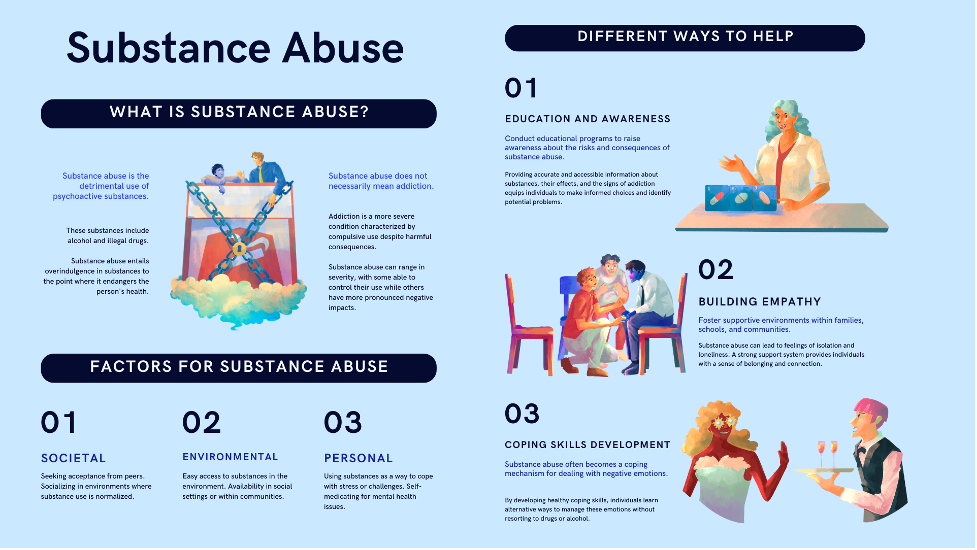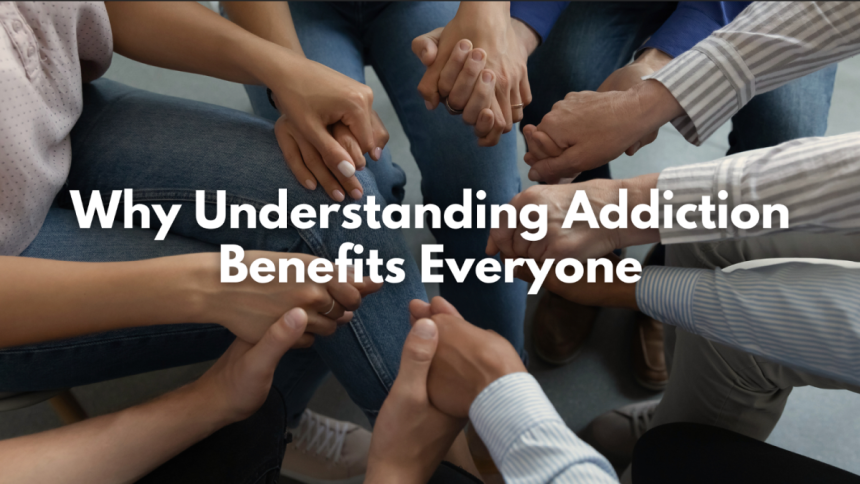Addiction isn’t merely a matter of self-control or moral failing; it’s also recognized as a chronic brain dysfunction that drives drug-seeking behavior despite adverse consequences. Prolonged drug abuse or engaging in addictive acts causes considerable diffuse structural and functional changes in the brain. These affect the brain’s motivation, reward, and decision-making processes, making it harder for individuals to control impulses and cravings. Moreover, addiction is often associated with comorbid mental health disorders such as anxiety, depression, and trauma. This complicates the treatment even more and calls for both addiction and psychological problems to be handled conjunctively.
The presence of stigma in patients with addiction aggravates their suffering and makes the provision of therapy more difficult and ineffective. Addicts often experience stereotyping of being morally reprehensible or irresponsible, and that attitude creates prejudices, social isolation and difficulties in accessing treatment. Instead of viewing addiction as a sign of moral weakness, the community could address the stigma and offer understanding and empathy to those trying to overcome addiction, recognizing it as a complex health issue.
Understanding Addiction
Addiction is a neurobiological issue within the brain that progresses it beyond the level of just a voluntary behavior. It pertains to the complex alterations that happen in the structure and function of the brain, mainly the mesolimbic pathway, often mentioned as the “brain’s reward system.” The brain’s reward system plays a crucial role in processing pleasure and driving individuals to engage in purposeful behavior. There is always a reoccurrence of the kind of brain chemicals that make people high, like Dopamine, which comes from chronic use of drugs or dependency on addictive behaviors.
These neurobiological changes involve not only the reward circuit but also other regulatory brain areas. Other regulatory brain areas, like the prefrontal cortex, get affected too. Suffering from addiction results in changes in the brain that affect emotion regulation, decision-making, risk assessment, as well as other standard processes. Moreover, such a deficit in the executive function could make it even more difficult for them to refuse cravings and prioritize long-term health instead of temporary pleasures.
Not only does addiction usually accompany other mental health issues, e.g., depression, anxiety, or trauma, but the presence of one illness highly increases the risk of the other. A unique characteristic of addiction is the mutuality effect when its symptoms are exacerbated by the associated psychiatric conditions and vice versa. Particularly, people may become addicted to drugs or carry out highly compulsive behaviors as a coping strategy to get rid of their emotional suffering (or existing problems). The situation is different when it comes to the development of substance abuse or addictive behaviors, which may, in turn, trigger or aggravate underlying psychological symptoms and end up in a never-ending cycle of dependency and disintegration of mental health.
The complex interplay between addiction and mental health disorders confirms the need for a broad-based and integrated therapeutic approach. Failing to address addiction in the context of the psychological vulnerabilities that underpin its development and maintenance is to ignore the fact that addiction happens in isolation. An integrative treatment model that considers the joint impact of addiction and mental health is essential for long-term recovery and overall wellness. Through the integration of treatment methods for substance use disorders and co-occurring psychiatric disorders, individuals can reach a deeper understanding and acquire coping skills and emotional strength, which can serve as a guide for living a better and happier life.

The Stigma Surrounding Addiction
Despite the groundbreaking breakthroughs in neuroscience and the positive effects that research has yielded in recent years, the stigma associated with addiction continues to grow in many societies, which results in many false beliefs and attitudes about people struggling with substance or behavioral addictions.
Instead of understanding addiction as a multifactorial disease based on the effects of neurotransmitters, society is too quick to leap to moral judgments and character evaluation. This stigma puts their moral worth in question, judging them as morally weak or lacking self-control, thus leading to discrimination and marginalization, which further contribute to them being isolated from support networks.
This level of social stigma not only compounds the suffering experienced by those in the midst of addiction but also creates obstacles that make access to vital treatment and support services very hard. The fear of being judged, rejected, or harming one’s career can, in many cases, prevent individuals from seeking help, which adds to a situation that worsens their loneliness and despair. Furthermore, the discrimination towards addiction invades the healthcare systems as well as the educational institutions and workplaces, which impedes the implementation of complete prevention, intervention, and recovery programs.
Though reframing addiction with empathetic, educative, and evidence-based knowledge may break down these established, narrow-minded perceptions, it may eventually build a culture of compassion and support. Labeling addiction as a complex medical illness by presenting the multiple aspects, such as neurobiological basis, genetic predispositions, and environmental influences, which are at the core of the problem, is what is really required.
One of the most effective ways to dispel stigma and foster supportive communities is by uplifting the voices of those struggling with drug abuse and by seeing them the way they should be seen: as persons with inherent worth and dignity. At the end of the day, this perception of dignity transforms into equal access to resources and opportunities for healing and recovery as the core values.
The Impact on Individuals and Families
Addiction continues to be a chronic disease that can have severe impacts on families. These families are usually engulfed with challenges as the disease tears apart every aspect of their whole process of living. Financial insecurity is widely experienced, exacerbated by the expenses associated with addressing addiction or its aftermath. The chances of losing a job, piling up debts, and depriving oneself of all kinds of security resources are just too many to mention, and they are the big enemies of a family’s success in relation to addiction.
The other side of it is that addiction may put a great toll on family bonds, division of trust, communication, and emotional ties. The dynamics within the house become rather cruel, and there is a lot of bickering and constant fights among family members. Children, in particular, are sadly burdened as their childhood is influenced by their parents’ addiction. Those particularly at risk for adverse effects are those exposed to an irregular environment characterized by neglect, violence, or instability.
Moreover, addiction cycles often lead to the intergenerational transfer of trauma to the children of addicted individuals, who may inherit genetic predispositions to substance abuse and mimic the behaviors and coping mechanisms they observe in family members facing similar issues. As children grow up in households that are disorderly, unstable, and fragmented, they are likely to become more prone to becoming alcoholics or drug addicts themselves. So, the vicious cycle of intergenerational issues is ironically reinforced.
However, whether viewed as a challenge or an opportunity, addiction recovery is often seen as a beacon of hope, offering a path to improved living, recovery, and resilience. Through educating the individuals and families about the physical and psychological indications, effects, or consequences of addiction, they now have the tools to uproot the problem and bring help and support to addicted individuals. Breaking away from the avoidance of facing the facts and the concealing secrets, families can be linked up to suitable programs and therapies aimed at tackling the roots of the addiction problem, after which they can launch a process of restoration and recovery.
Comprehensive therapeutic approaches, interventions, and support systems can help the individuals’ families regain their supremacy over their lives and begin a process of recovery characterized by resilience, endurance, and hope. By fostering resilience and facilitating community bonding, efforts to understand addiction can become catalysts for change, allowing families to move beyond addiction’s darkness and envision a life renewed with hope and opportunity.
The Societal Costs of Addiction
The ripple effects of drug abuse go beyond personal realms, posing a critical challenge to the economic and social structures of societies at local and global levels. The system of healthcare is under enormous pressure when it comes to solving problems related to addiction-related health conditions, from the immediate medical issues associated with drug abuse first-hand to the long-lasting consequences of chronic conditions such as liver failure and cardiac disorders, among others. The outlays of hospitalizations, emergency rooms, rehabilitation programs, and pharmaceutical inputs turn healthcare budgets into a matter of dollars and cents, leaving no money for other essential healthcare services.
Additionally, the criminal justice system also comes in tangent with addiction, creating a vicious cycle of imprisonment, re-incarceration, and social alienation. Law enforcement agencies struggle hard in the implementation of drug-related laws, weakening budgets through policing, prosecution, and incarceration. The overloading of jails with nonviolent drug offenders not only exacerbates the already dire systemic inequity and racial disparities but also fails to address the fundamental factors that led to substance abuse and criminal behavior.
Furthermore, abuse of drugs not only affects the productivity of the economy but also leads to the inability of individuals to hold employment, fulfill their professional role, or contribute meaningfully to the workforce. Substance abuse, absenteeism, less productivity, and work-related accidents lead employers and businesses to lose productive labor. The situation results in the death of the young generation due to drug overdose, accident, or related health problems that again reduce human capital and strain the social support systems.
Yet, when society perceives addiction as a health issue instead of immoral behavior, evidence-based programs for prevention, treatment, and harm reduction that target root causes and minimize the societal effects of addiction can be implemented. The allocation of funds for treatment and drug programs saves lives and provides considerable financial returns by trimming down long-term medical costs, crime rates, and unproductivity losses.
By emphasizing timely intervention, gap-free treatment services, and community-based support groups, societies can end the chain of dependence, rehabilitation, and the prosperity of not only individuals and families but also whole communities. The admission of a public health stand to addiction enlightens the value of concerted efforts, creativity, and sympathy in resolving the most formidable problem facing nearly all societies globally.
The Role of Education and Prevention
The educational and prevention measures are fundamental columns in the battle against drugs and addiction, better-equipping individuals and communities with the knowledge and skills needed to understand drug abuse problems and overcome addiction. Education initiatives will, therefore, be essential in dispensing information about the different risk factors and consequences of addiction, giving people a deep understanding of the complex nature of this disease. Armed with this knowledge, people can make informed decisions about their substance usage and recognize people who are already addicted or are on the edge of being addicted.
School-based prevention programs, which have been proven to be among the best early intervention strategies, target young people who are still forming their mindsets and, hence, are the most malleable. At the same time, they are enlightened with life skills and resilience techniques to withstand social, emotional, and peer pressure and any other societal influence. These initiatives translate to increased understanding and support for developing sound coping mechanisms, and numerous studies unveil the reality that abuse of drugs and addictive behaviors are deterring students from doing the deed.
Community outreach and public awareness campaigns serve as starting points for change by defeating old attitudes and prejudices that were formed about addiction. In this way, people will become more compassionate, understanding, and supportive of those who overcome addiction. Through giving a platform to various voices and sharing individual stories of overcoming that are filled with evidence of strength and perseverance, these campaigns help individuals connect with those affected by substance abuse and to battle stigma, eventually achieving an inclusive environment that focuses on compassion and unity.
Treatment and Recovery
Last but not least, early detection, as well as screening programs, give the chance to identify at-risk individuals and bring preventive interventions before the addiction goes beyond the control of an individual. Mental health screening, together with substance abuse screening and routine primary healthcare, is considered to be an essential tool that helps health service providers to detect the causes of addiction, such as traumas, poverty, and social inequality. Through this additional screening process, providers can offer targeted interventions and direct people to get help from evidence-based treatment and support services so that fewer people become addicted and people are encouraged toward overall wellbeing.
Adequate treatment and supportive measures need to be in place to facilitate rehabilitation. It is, however, quite unfortunate that among the numerous challenges that are being experienced in addiction treatment is the lack of quality addiction treatment services worldwide. Multiple situations like financial constraints, lack of healthcare insurance coverage, and the low number of specialized treatment facilities remain as the main obstacles that impede several people from running on the treatment roadmap.
Advocating for policies that mainstream primary treatment access expansion and merging mental health services into primary care setting concerns is very important to think about how this issue could be resolved. By smashing obstacles and allowing treatment to reach anyone who needs it, we can ultimately raise the raft of services and support offered to drug-addiction patients.
A homely environment that encourages acceptance and support as critical elements for a recovery-enabling space is also necessary. Destigmatizing addiction would also involve sending out the message through open talks, education, and other awareness campaigns to debunk harmful beliefs within society. Organizations can do this by telling stories of success and strength through stories of struggles, and this will offer others the hope they need to see them through the challenges the bane of addiction brings, as well as foster that sense of community and solidarity on the road to recovery.
Conclusion
Addressing the facets of addiction is not just helpful but is necessary to improve the health, welfare, and social justice of individuals. By understanding the multifaceted medical condition that makes some individuals become addicted rather than a mere indisposition to accept the stigma, people can lay the foundation to create more empathetic and supportive communities for those who are in recovery. Allocating a budget for educational purposes, prevention, treatment, and recovery services is not a moral duty alone, but is a wise and strategic approach that benefits all involved members from individual and family levels to the whole society.
Encouraging society to perceive addiction as a complicated medical disorder should serve as a way of smashing the myths and prejudices, which in turn would decrease stigma and discrimination against people with these kinds of problems. Instead of finding fault in people for their plight, the community can spread empathy and compassion, realizing that addiction can happen to anyone and is actually caused by complicated interactions of genetics, upbringing, and psychology. By shifting from the judgmental to the compassionate narrative, everyone can make the environment safe to ask for help and support without fear that people will condemn or isolate them.
Finally, supporting full-service addiction interventions not only deals with addiction itself but also brings a lot of benefits to society. Education and prevention efforts help people understand and make decisions that ensure healthy behavior. This in turn, is a way of preventing addiction and its associated problems. Availability of first-rate treatment and recovery services minimizes death rates and relieves the strain placed on the healthcare, justice, and social welfare systems. Through public health, people can advocate for a fair and just society where everyone gets a chance to get quality treatment and support they need to lead a quality life.
FAQs
What exactly is addiction?
Addiction is a chronic brain disorder characterized by compulsive drug seeking despite harmful consequences. It involves significant changes in the brain’s structure and function, impacting areas related to motivation, rewards, and decision-making.
How does stigma affect individuals with addiction?
Stigma exacerbates the suffering of individuals with addiction, leading to discrimination, social exclusion, and barriers to accessing treatment. It perpetuates harmful stereotypes and prejudices, hindering efforts to provide effective support and care.
Why is understanding addiction important for society?
Understanding addiction as a complex medical condition helps combat stigma and promotes empathy and compassion for individuals seeking recovery. By investing in education, prevention, treatment, and recovery services, society can create supportive environments that benefit everyone involved.
Lynn Martelli is an editor at Readability. She received her MFA in Creative Writing from Antioch University and has worked as an editor for over 10 years. Lynn has edited a wide variety of books, including fiction, non-fiction, memoirs, and more. In her free time, Lynn enjoys reading, writing, and spending time with her family and friends.















